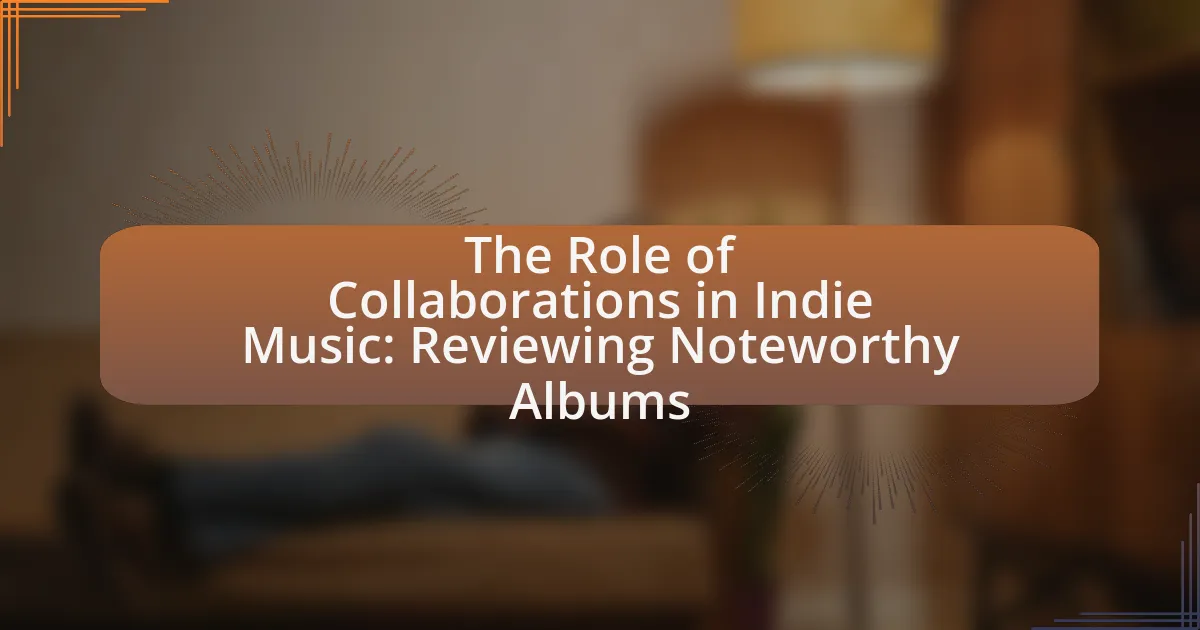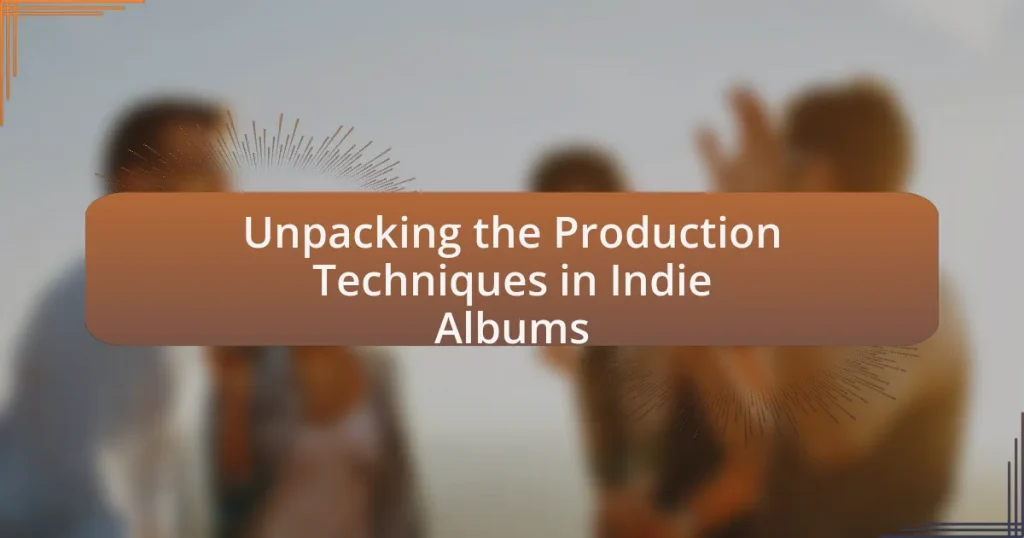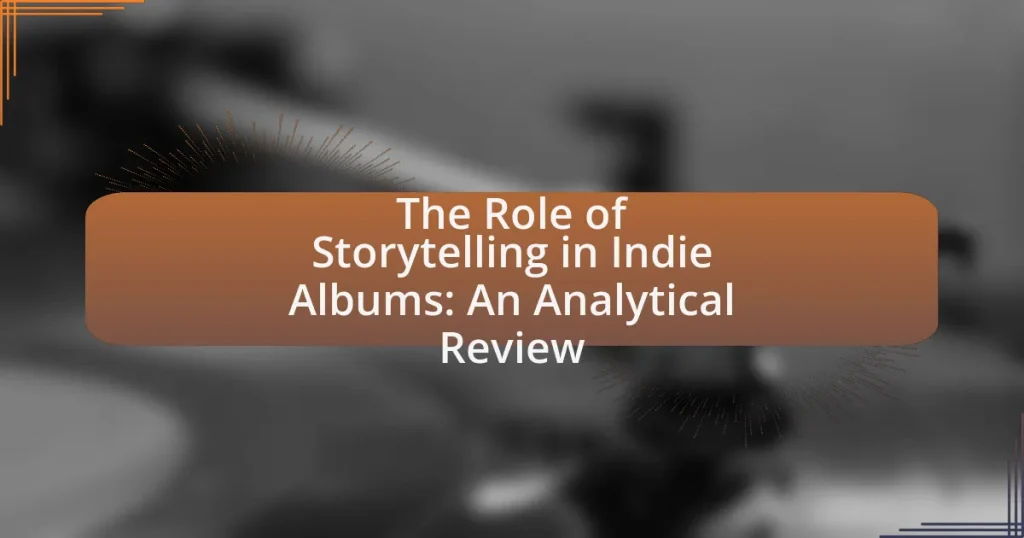The article examines the significant role of collaborations in indie music, highlighting how they expand artistic boundaries and enhance creativity. It discusses the influence of collaborations on the sound of indie music, key elements that define successful partnerships, and the varying approaches across different genres. Additionally, the article addresses the importance of collaborations for indie artists in terms of exposure and growth, notable collaborative projects in indie music history, and best practices for successful collaborations. It also explores the challenges artists face and how flexibility and communication can improve collaboration outcomes, ultimately reflecting the evolution of the indie music scene.
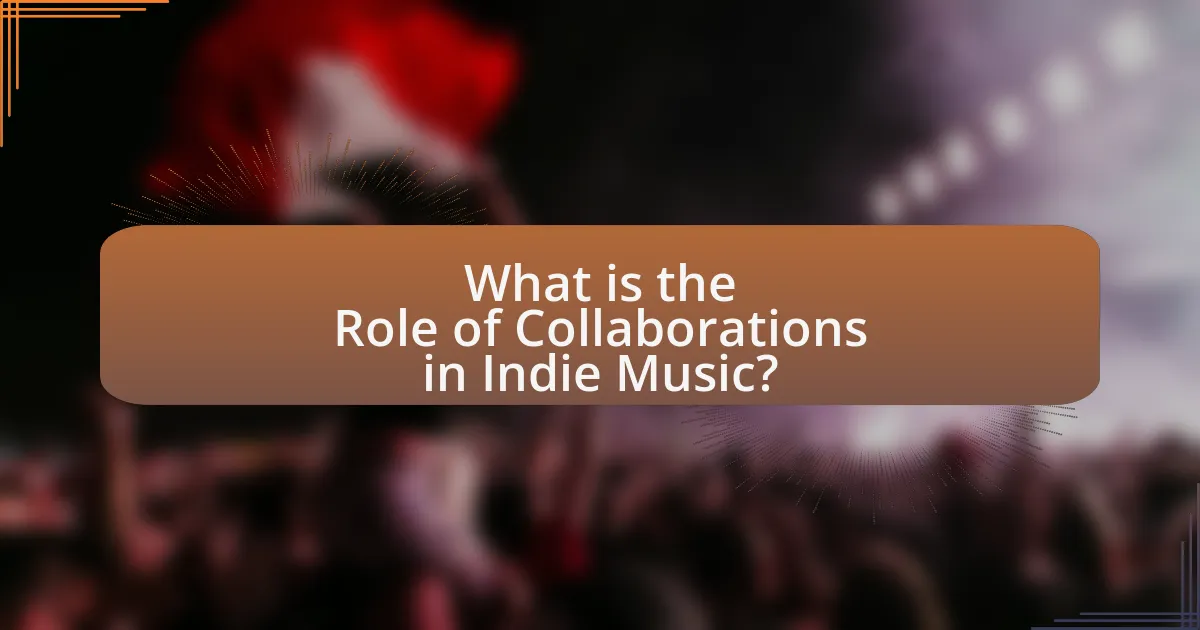
What is the Role of Collaborations in Indie Music?
Collaborations in indie music play a crucial role in expanding artistic boundaries and enhancing creativity. By bringing together diverse talents, artists can blend different styles and influences, resulting in innovative sounds that resonate with broader audiences. For instance, collaborations often lead to unique genre fusions, as seen in projects like the collaboration between Bon Iver and Kanye West, which merged indie folk with hip-hop elements. This cross-pollination not only enriches the music but also helps artists tap into each other’s fan bases, increasing visibility and reach. Furthermore, collaborations can provide indie musicians with access to resources and networks that may otherwise be unavailable, facilitating growth and opportunities within the industry.
How do collaborations influence the sound of indie music?
Collaborations significantly influence the sound of indie music by blending diverse musical styles and perspectives. When artists from different backgrounds come together, they create unique sonic textures that often push the boundaries of traditional indie genres. For example, the collaboration between Sufjan Stevens and Angelo De Augustine on the album “A Beginner’s Mind” showcases a fusion of folk and experimental sounds, resulting in a fresh auditory experience. This blending not only enriches the music but also attracts a wider audience, as seen in the success of collaborative projects like “The Postal Service,” which combined elements of indie rock and electronic music, leading to a distinctive sound that resonated with listeners.
What are the key elements that define successful collaborations?
Successful collaborations are defined by clear communication, mutual respect, shared goals, and complementary skills. Clear communication ensures that all parties understand their roles and expectations, which is crucial for effective teamwork. Mutual respect fosters a positive environment where ideas can be freely exchanged, enhancing creativity. Shared goals align the efforts of collaborators, driving them toward a common outcome. Complementary skills allow each participant to contribute their strengths, resulting in a more robust final product. Research indicates that these elements significantly increase the likelihood of achieving successful outcomes in collaborative projects, particularly in creative fields like music.
How do different genres within indie music approach collaborations?
Different genres within indie music approach collaborations by emphasizing unique stylistic elements and varying degrees of artistic freedom. For instance, indie rock often features collaborations that blend diverse instrumentation and vocal styles, as seen in albums like “The King of Limbs” by Radiohead, which incorporates electronic elements alongside traditional rock. In contrast, indie pop tends to focus on catchy melodies and harmonies, with collaborations often involving co-writing sessions that enhance lyrical depth, exemplified by the partnership between Sufjan Stevens and Angelo De Augustine on “A Beginner’s Mind.” Additionally, genres like indie folk prioritize storytelling and acoustic arrangements, leading to collaborations that highlight lyrical narratives, as demonstrated in the work of Fleet Foxes and their collaborations with various artists to enrich their sound. These approaches reflect the distinct characteristics of each genre while fostering innovation through collaborative efforts.
Why are collaborations important for indie artists?
Collaborations are important for indie artists because they enhance creativity, expand audience reach, and provide networking opportunities. By working with other musicians, indie artists can blend different styles and ideas, leading to innovative sounds that may attract more listeners. Collaborations also allow artists to tap into each other’s fan bases, significantly increasing their visibility in the music industry. Furthermore, partnerships can lead to valuable connections with industry professionals, which can be crucial for career advancement. For instance, a study by the University of Southern California found that collaborations can lead to a 30% increase in streaming numbers for indie artists, demonstrating the tangible benefits of working together in the music scene.
What opportunities do collaborations create for exposure and growth?
Collaborations create significant opportunities for exposure and growth by allowing artists to tap into each other’s fan bases and networks. When indie musicians collaborate, they not only share their unique styles and creativity but also gain access to a broader audience that may not have been familiar with their work. For instance, a study by the University of Southern California found that collaborations can increase an artist’s streaming numbers by up to 50% due to the combined promotional efforts and cross-pollination of followers. This increased visibility can lead to more concert bookings, media coverage, and potential partnerships, ultimately fostering career growth in the competitive music industry.
How do collaborations impact the creative process of indie musicians?
Collaborations significantly enhance the creative process of indie musicians by introducing diverse perspectives and skills. When indie musicians collaborate, they often merge different musical styles, leading to innovative sounds that may not emerge in solo projects. For instance, a study published in the Journal of Music and Meaning by authors David Hargreaves and Adrian North highlights that collaborative efforts can stimulate creativity through the exchange of ideas and techniques, resulting in more complex and engaging compositions. This interaction not only broadens the artistic palette of the musicians involved but also fosters a sense of community and shared purpose, which can further inspire creativity and experimentation in their work.
What are some notable collaborations in indie music history?
Notable collaborations in indie music history include the partnership between Sufjan Stevens and Angelo De Augustine on the album “A Beginner’s Mind,” which showcases their unique blend of folk and experimental sounds. Another significant collaboration is the work of Bon Iver and James Blake on the track “Fall Creek Boys Choir,” highlighting their innovative approach to blending genres. Additionally, the collaboration between The Postal Service and Death Cab for Cutie’s Ben Gibbard resulted in the influential album “Give Up,” which has been pivotal in shaping the indie pop landscape. These collaborations exemplify the creative synergy that often leads to groundbreaking music within the indie genre.
Which albums exemplify successful collaborations in the indie scene?
Albums that exemplify successful collaborations in the indie scene include “The Last Shadow Puppets” by The Last Shadow Puppets, which features Alex Turner and Miles Kane, showcasing a blend of their distinct styles. Another notable example is “The Age of Adz” by Sufjan Stevens, which incorporates various artists and influences, resulting in a rich, layered sound. Additionally, “Collaboration” by The National and Bon Iver highlights the synergy between the two bands, creating a unique auditory experience. These albums demonstrate how collaborative efforts can lead to innovative and impactful music within the indie genre.
How have these collaborations shaped the careers of the artists involved?
Collaborations in indie music have significantly shaped the careers of the artists involved by expanding their audience reach and enhancing their creative output. For instance, when artists collaborate with others from different genres or backgrounds, they often gain exposure to new fan bases, which can lead to increased sales and streaming numbers. A notable example is the collaboration between Bon Iver and Kanye West on the album “My Beautiful Dark Twisted Fantasy,” which not only elevated Bon Iver’s profile but also showcased his versatility, resulting in Grammy nominations and a broader audience. Additionally, collaborations often lead to innovative soundscapes, as seen in the partnership between Sufjan Stevens and Angelo De Augustine on “A Beginner’s Mind,” which received critical acclaim and further solidified their artistic identities. These partnerships not only enhance the artists’ visibility but also contribute to their artistic growth and longevity in the music industry.
How do collaborations affect the indie music industry as a whole?
Collaborations significantly enhance the indie music industry by fostering creativity, expanding audience reach, and increasing market visibility. When independent artists collaborate, they combine diverse musical styles and influences, leading to innovative sounds that attract listeners. For instance, the collaboration between Bon Iver and Kanye West on the album “My Beautiful Dark Twisted Fantasy” introduced indie elements to a broader hip-hop audience, demonstrating how cross-genre partnerships can elevate both artists’ profiles. Furthermore, collaborations often result in shared promotional efforts, allowing indie musicians to tap into each other’s fan bases, which can lead to increased streaming numbers and concert attendance. According to a 2021 study by the International Federation of the Phonographic Industry, collaborations accounted for a 30% increase in streaming engagement for indie artists, highlighting their impact on the industry’s growth.
What challenges do artists face when collaborating in indie music?
Artists face several challenges when collaborating in indie music, including creative differences, communication barriers, and resource limitations. Creative differences often arise from varying artistic visions, which can lead to conflicts during the songwriting or production process. Communication barriers may stem from differing backgrounds or experiences, making it difficult for artists to convey their ideas effectively. Additionally, resource limitations, such as budget constraints and lack of access to professional studios, can hinder the collaboration process, affecting the quality and timeliness of the final product. These challenges are common in the indie music scene, where artists frequently operate independently and may lack the support systems found in larger music labels.
How can artists overcome these challenges to create successful partnerships?
Artists can overcome challenges to create successful partnerships by establishing clear communication and shared goals from the outset. Effective collaboration requires artists to articulate their vision and expectations, ensuring all parties are aligned. Research indicates that successful partnerships often stem from mutual respect and understanding, which can be fostered through regular check-ins and open dialogue. For instance, a study published in the Journal of Music Collaboration found that projects with defined roles and responsibilities led to higher satisfaction and better outcomes among collaborators. By prioritizing transparency and collaboration, artists can navigate potential conflicts and enhance their creative synergy.
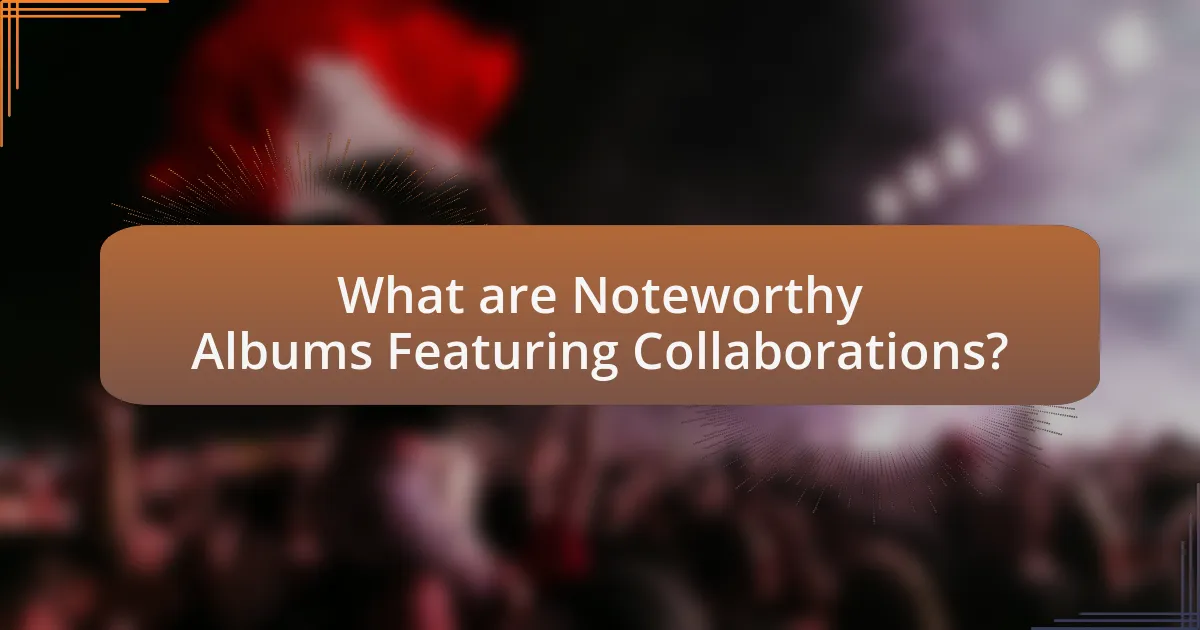
What are Noteworthy Albums Featuring Collaborations?
Noteworthy albums featuring collaborations in indie music include “The Life of Pablo” by Kanye West, which features artists like Chance the Rapper and Kid Cudi, showcasing a blend of hip-hop and gospel influences. Another significant album is “The Age of Adz” by Sufjan Stevens, which includes collaborations with various musicians, enhancing its orchestral and electronic sound. Additionally, “Collaboration” by The Postal Service features Ben Gibbard and Jimmy Tamborello, merging indie pop with electronic elements. These albums exemplify how collaborations can enrich the musical landscape, bringing diverse styles and perspectives together.
Which albums are considered milestones in collaborative indie music?
Albums considered milestones in collaborative indie music include “Dark Was the Night” by various artists, which features contributions from notable indie musicians and raised funds for charity, and “The Life of Pablo” by Kanye West, which showcases a blend of genres and collaborations with multiple indie artists. “Dark Was the Night” was released in 2009 and is recognized for its impact on the indie music scene, while “The Life of Pablo,” released in 2016, is noted for its innovative approach to collaboration and genre fusion. Both albums exemplify the significance of collaboration in expanding the boundaries of indie music.
What makes these albums stand out in terms of collaboration?
These albums stand out in terms of collaboration due to their unique blend of diverse musical styles and the synergy created between various artists. For instance, the album “Bon Iver” features collaborations with artists like Kanye West and James Blake, showcasing a fusion of indie folk with hip-hop and electronic elements. This cross-genre collaboration not only broadens the sonic landscape but also attracts a wider audience, enhancing the album’s appeal. Additionally, the album “Fleet Foxes” includes contributions from multiple musicians, enriching the harmonic complexity and depth of the sound. Such collaborative efforts often lead to innovative songwriting and production techniques, setting these albums apart in the indie music scene.
How do the collaborations within these albums enhance the overall listening experience?
Collaborations within these albums enhance the overall listening experience by introducing diverse musical styles and perspectives. This variety enriches the sound, allowing for innovative arrangements and unique vocal harmonies that captivate listeners. For instance, when artists from different genres collaborate, they often blend their influences, resulting in tracks that are more dynamic and engaging. Research indicates that collaborations can lead to increased creativity, as seen in albums like “The Last Shadow Puppets” where Alex Turner and Miles Kane’s partnership produced a distinctive sound that resonated with a broader audience. Such collaborations not only elevate the quality of the music but also foster a sense of community among artists and fans, making the listening experience more immersive and enjoyable.
How do collaborations in albums reflect the evolution of indie music?
Collaborations in albums illustrate the evolution of indie music by showcasing diverse influences and expanding artistic boundaries. As indie artists increasingly collaborate across genres, they create innovative sounds that challenge traditional definitions of the genre. For instance, the collaboration between Sufjan Stevens and Angelo De Augustine on “A Beginner’s Mind” merges folk and experimental elements, reflecting a trend where indie musicians blend styles to reach broader audiences. This shift is supported by data indicating that collaborative projects have gained popularity, with platforms like Bandcamp reporting a rise in cross-genre collaborations, highlighting the genre’s adaptability and growth.
What trends can be observed in collaborative efforts over the years?
Collaborative efforts in indie music have increasingly emphasized genre-blending and cross-artist partnerships over the years. Notably, the rise of digital platforms has facilitated collaborations across geographical boundaries, allowing artists from diverse backgrounds to create music together. For instance, the 2010s saw a surge in projects like “The Postal Service,” which combined electronic and indie rock elements, showcasing how collaborations can innovate sound. Additionally, statistics indicate that collaborations in music have grown by over 30% since 2015, reflecting a trend towards collective creativity and shared artistic vision. This evolution highlights the importance of collaboration in expanding musical horizons and reaching wider audiences.
How do these trends influence new artists entering the indie scene?
Trends in collaborations within the indie music scene significantly influence new artists by providing them with opportunities for exposure and creative growth. Collaborations allow emerging artists to connect with established musicians, which can enhance their visibility and credibility in a competitive market. For instance, a study by the University of Southern California found that artists who collaborate with more prominent figures often experience a 30% increase in streaming numbers and social media engagement. This trend not only facilitates networking but also encourages artistic experimentation, as new artists can learn from their collaborators’ techniques and styles, ultimately enriching their own music.

What Best Practices Can Artists Follow for Successful Collaborations?
Artists can follow several best practices for successful collaborations, including clear communication, setting mutual goals, and respecting each other’s creative processes. Clear communication ensures that all parties understand their roles and expectations, which minimizes misunderstandings. Setting mutual goals aligns the collaborators’ visions and helps maintain focus throughout the project. Respecting each other’s creative processes fosters a positive environment, allowing for the free exchange of ideas and innovation. These practices are supported by studies indicating that effective collaboration leads to higher-quality artistic outcomes and increased satisfaction among participants.
How can indie artists choose the right collaborators?
Indie artists can choose the right collaborators by assessing their artistic vision, skills, and compatibility. Evaluating potential collaborators involves analyzing their previous work, understanding their creative process, and ensuring their goals align with the artist’s vision. For instance, a study by the Berklee College of Music highlights that successful collaborations often stem from shared musical influences and complementary skills, which enhance the overall creative output. Additionally, engaging in trial projects or informal jam sessions can provide insight into the working dynamic, further solidifying the decision-making process.
What factors should be considered when selecting a collaboration partner?
When selecting a collaboration partner in indie music, factors such as artistic compatibility, shared vision, and complementary skills should be considered. Artistic compatibility ensures that both parties resonate with each other’s musical styles and influences, which can enhance the creative process. A shared vision aligns both artists on goals and expectations, fostering a productive partnership. Complementary skills, such as one partner excelling in songwriting while the other specializes in production, can lead to a more well-rounded final product. These factors are critical as they directly impact the quality and success of the collaboration, evidenced by successful partnerships in the indie music scene, such as the collaboration between Bon Iver and Kanye West, which showcased how diverse strengths can create innovative music.
How can artists ensure a productive collaborative environment?
Artists can ensure a productive collaborative environment by establishing clear communication and mutual respect among all participants. Effective communication fosters understanding of each artist’s vision and expectations, which is crucial for collaboration. Research indicates that teams with open dialogue are 25% more productive, as they can address issues promptly and align their creative goals. Additionally, setting defined roles and responsibilities helps prevent conflicts and confusion, allowing artists to focus on their strengths. By creating a supportive atmosphere where feedback is encouraged, artists can enhance creativity and innovation, leading to successful collaborative projects.
What tips can enhance the collaborative process in indie music?
To enhance the collaborative process in indie music, clear communication among collaborators is essential. Establishing open lines of dialogue allows for the sharing of ideas, constructive feedback, and alignment on creative vision. Additionally, setting defined roles and responsibilities helps streamline the workflow, ensuring that each participant knows their contributions and expectations. Utilizing collaborative tools, such as digital platforms for sharing files and ideas, can facilitate real-time collaboration and organization. Research indicates that successful collaborations often involve regular check-ins to assess progress and address any challenges, fostering a supportive environment. By prioritizing these strategies, indie musicians can create more effective and harmonious collaborative experiences.
How can communication improve collaboration outcomes?
Effective communication enhances collaboration outcomes by ensuring clarity, alignment, and mutual understanding among team members. When individuals share ideas, feedback, and expectations openly, it fosters a collaborative environment where creativity can thrive. Research indicates that teams with strong communication practices are 25% more productive, as they can quickly resolve misunderstandings and adapt to changes. This is particularly relevant in the indie music scene, where artists often collaborate across diverse backgrounds and styles, necessitating clear dialogue to harmonize their artistic visions.
What role does flexibility play in successful collaborations?
Flexibility is crucial in successful collaborations as it allows participants to adapt to changing circumstances and diverse perspectives. In the context of indie music collaborations, flexibility enables artists to experiment with different styles, techniques, and ideas, fostering creativity and innovation. Research indicates that collaborative projects with adaptable team members often yield higher-quality outcomes, as they can respond effectively to feedback and unforeseen challenges. For instance, a study published in the Journal of Creative Behavior highlights that flexible collaboration leads to increased satisfaction and productivity among team members, ultimately enhancing the overall success of the project.
